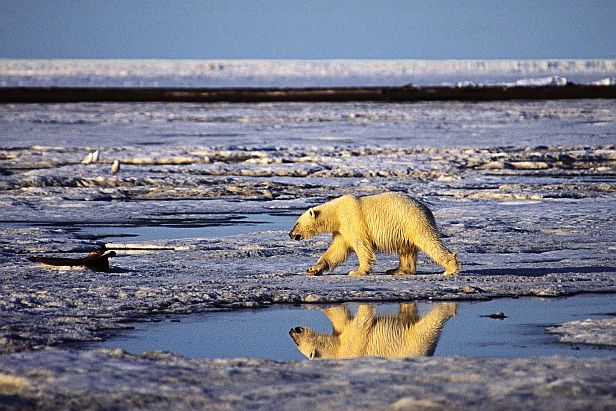 This image of a polar bear on Barnard Harbor in Alaska was used in a Senate debate about the Arctic National Wildlife Refuge.Photo: Subhankar Banerjee
This image of a polar bear on Barnard Harbor in Alaska was used in a Senate debate about the Arctic National Wildlife Refuge.Photo: Subhankar Banerjee
“Art has always reflected what is in our world and in our horizon and what our fears are — which is all tied in to climate change.” Coco Howard, Seattle artist
In 2003, a Senate debate turned into an art show for a moment. In the heat of an argument over drilling in the Arctic National Wildlife Refuge, Sen. Barbara Boxer (D-Calif.) held up an image of a polar bear crossing a frozen harbor. That image, taken by photographer Subhankar Banerjee, was dynamic and colorful and full of life — everything, in fact, that drilling advocates had argued the Refuge was not.
It wasn’t the first time art had played a role in the politics of preservation. As Victoria Anstead, an environmental art curator and advisor, points out, the iconic black-and-white images of Ansel Adams helped expand the national park system. “It helped give people enough information that they could … know that issue intimately enough that they would vote the way you wanted them to — to preserve the land,” she says.
The same effect is possible, say artists and activists, around the issue of climate change. Art can reach people in unexpected ways, can make abstract political issues come alive and lead people to take action. And increasingly, climate art is appearing in unexpected places.
That wasn’t the case four years ago, when author Bill McKibben asked “Where is the art about climate change?“
Benjamin Drummond and Sara Joy Steele answered that call. (Read McKibben’s new essay to see who else is getting involved.) McKibben’s words got the photographer/writer pair thinking about a recent trip they’d taken to interview members of the Iceland Glaciological Society, volunteers (from sheepherders to plastic surgeons) who measure and document the advance and retreat of glaciers in their own backyards.
Hoping to shift the debate from “is it happening or isn’t it” to “how do we cope,” the duo launched a large-scale multimedia project called “Facing Climate Change” in 2006. Through images, words, and audio clips, they are telling the stories of people affected by and adapting to climate change. (Hear wildland firefighter Joe King talk about wildfire suppression in the American West.)
“I think it’s really the job of documentary and creative arts to take this issue and put it inside our psyche,” Drummond says. “There’s something about these visual arts that can take the emotive sides of [climate change] and really steep us in it so we have this deeper understanding of the issue.”
 Chris Jordan’s “Gyre” is actually made from 2.4 million bits of plastic.Courtesy Chris JordanFor artist Chris Jordan, deeper understanding comes with breaking down complex concepts into digestible bits. Or in the case of his recent piece “Gyre,” 2.4 million bits — of plastic.
Chris Jordan’s “Gyre” is actually made from 2.4 million bits of plastic.Courtesy Chris JordanFor artist Chris Jordan, deeper understanding comes with breaking down complex concepts into digestible bits. Or in the case of his recent piece “Gyre,” 2.4 million bits — of plastic.
That number, 2.4 million, represents the estimated pounds of plastic pollution reaching the ocean every hour. In writing, it is surprising, but assembled Seurat-style into a re-creation of Hokusai’s “The Great Wave off Kanagawa,” that number becomes staggeringly comprehendible.
“There are actually all these studies out there … demonstrating that the human mind doesn’t have the ability to comprehend numbers more than a few thousand,” Jordan says. “And yet, all of the numbers associated with global warming are all these astronomical, huge numbers that are so hard for us to feel anything about.”
Numbers like 4 trillion, which is the number of pounds of carbon dioxide generated each year by coal-fired power plants. Or even 63,000, the number of pounds of coal burned in the United States each second. Jordan incorporates both into another new piece, created as part of a Sierra Club campaign to fight mountaintop removal mining. (Hear Jordan explain the numbers in this audio slideshow.)
“I think that’s one of the most powerful roles that art can play in culture is to shine a light on our collective shadow,” Jordan says, “to bring things out from the shadow and illuminate them.”
Interactive media artist Rebecca Bray, who helped created the hugely popular and effective “Meatrix” animations, agrees: “Art can traverse these boundaries between being not just gorgeous but also thought-provoking and responsive and very personal.”
Like Jordan, Bray is looking to use her artistic talents to help people break complex environmental issues down into smaller problems that seem solvable, but she’s aiming for a much more hands-on approach. She and fellow artist Britta Riley have started focusing on the concept of R&D-I-Y (research and develop it yourself), a “crowdsourcing initiative” that focuses on environmental problems. “We can’t always wait for scientists and research institutions to come up with solutions,” she says.
Their latest endeavor involves the use of recycled local materials to create vertical window farms that serve as décor — and dinner. (Umbra Fisk chats with Bray and Riley while offering video advice on how to grow food in a small space.) And now they’re sharing their functional art project, via workshops and web demos, with a much larger population.
“Climate change is something that people share in common. Everyone from Sámi reindeer herdsmen and wildland firefighters, to high school students, lawyers, and prisoners, must confront and adapt to climate change,” Steele says. “Our hope is that by combining these universal things, art and climate change, we can influence people to act — soon.”


